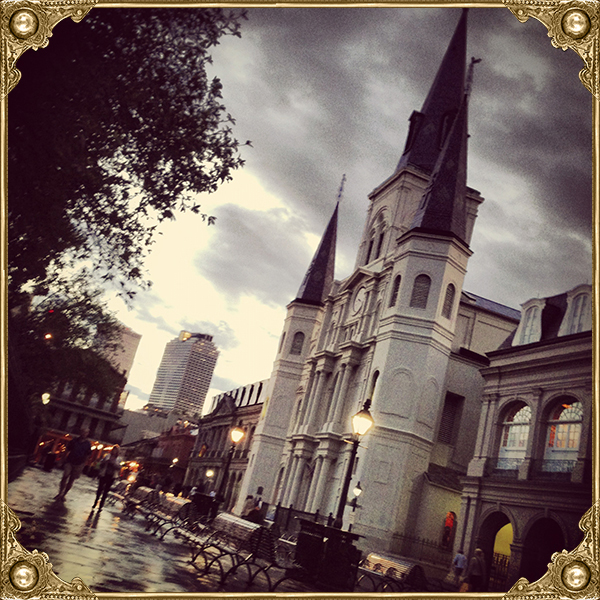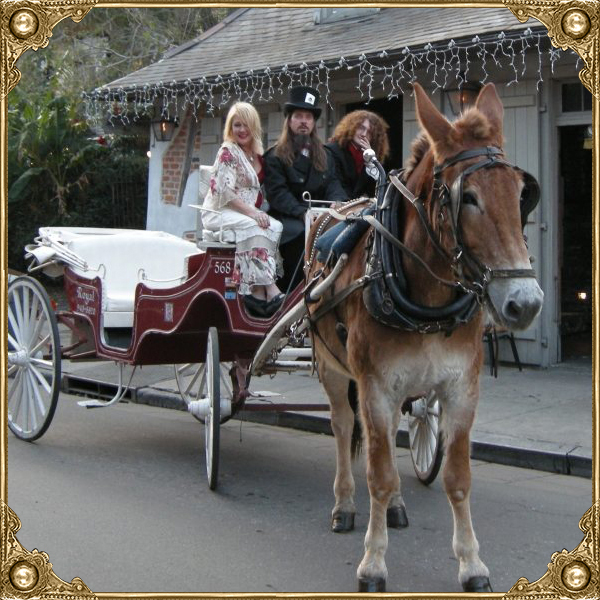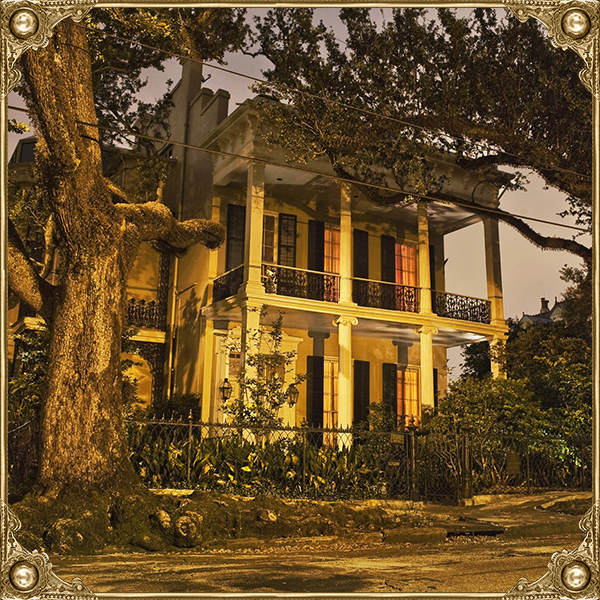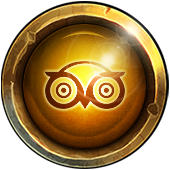NEW ORLEANS HISTORY
SPOTLIGHT INTERVIEW
Post Katrina New Orleans Voodoo Documentary
Film 2013
Loyola University oral history documentary with Bloody Mary, Mambo Gina and Conjureman Orion.
• • •
ABOUT NEW ORLEANS
• • •
Discover our culturally rich epicenter
of music, mysticism and the macabre!


Many illuminating facets are part of New Orleans, they draw you in and cast a spell, but the underlying feeling of our sultry city comes from the Spirit of Place—the genus loci. A town has her own spirit, ours spreads from the river—through the square and deep into our hearts. Many who visit here feel as if they have been here before in past lives of old souls.
Visitors come and immediately want to stay for good— many do. People from foreign lands comment how most of America is the same, but they discover New Orleans stands on its own, full of old-world charm and European flare. Not the architecture— though much of it is indeed European-inspired and breathtaking— but also in its culture, lifestyle, ambiance, and local traditions.


From the Spanish style of the Vieux Carré balconies to the elegant Garden District mansions, even all the way down to our simple shotgun homes and bayou camps with their swamp appeal, it is all the Spirit of New Orleans herself that has possessed your senses. We are unique and proud to call this home.
Welcome to our history and mystery. Let us show you more about our unique city.
The indulgences of the flesh abound in New Orleans and will indeed engage you but so will the Spirit World.
Welcome to America’s most haunted city!
AREAS OF INTEREST
• • •
BIG WATERS: THE MISSISSIPPI
The Mississippi is a river like no other—her arms reach out through 41% percent of America; her heart contains the lifeblood and history of a nation. Listen to her speak and a world like you have never known opens her doors! Many a man has fallen in love with her and died within her too. She has built powerful empires and destroyed others along the way. She is hard to resist, especially here in this beautiful crescent we call home.
New Orleans is her mouth, her breath, the soul of America inspiring and commanding us to live!
According to, John M. Barry in Rising Tide, “…the Mississippi is the longest river in the world, and it pulses like an artery of the American heartland.” We are her children and the mighty Mississippi is the only reason we came. The natives gloried in her wonders: they fed, they sang, and they danced in her name. Then the French found their way here simply to claim control. Greed and lust their main game: we were strategic territory. The area from Canada to New Orleans seemed to spell power, position, and money. Simple, or so they thought. Big Waters fought back in many ways, for a force of nature such as she could not truly be controlled, though many have tried.
From the window of the haunted restaurant of Muriel’s at Jackson Square, you could slip back in time and watch the history of New Orleans unfold. This territory claimed by La Salle for France in 1698 gave birth to the city known as La Nouvelle Orleans, officially in 1718. Bienville founded this settlement with high hopes, but it was the Scottsman, John Law, who swindled settlers from all around the world to come here. The colony suffered many a blow and lay abandoned to her fate. New Orleans seemed nothing more than a weak military outpost at best, only hopes and fears remaining. True, it was a natural port with serpentine crescent shape, but plague, flood and pestilence were ever knocking at our door. New Orleans was, and always has been, a giant swamp at its heart.
They say it was the French that founded New Orleans; though the Native Americans had been here for thousands of years before! It was the Spaniards who invested enough make New Orleans a viable city, it was the Africans who made it run and gave us our distinctive song, it was sugar cane that sweetened the pot enriching our city and our flavor, and it was the Mississippi herself who embraced us, seducing a nation with our charms. As United States’ city since 1803, we remain unique bastion of European and African culture. We are “proud to swim home!” as the post-Katrina locals now say. All the deeds of past and the future are ever present here embedded and imprinted into our Mississippi Mud —a haunting truth, ever repeating in a ghostly replay in modern day.
Yet our River’s mother nature still gave and gave amidst it all. Her alluvial soils sprang forth a cash crop of no compare, sugar cane. Sweetness that let us claim our fame as the richest town around! But she knew things had to change, human rights abused, control and greed gave way to war that tore the USA apart! Then the rails curled round this Chaos wrath and a new King was born in towns; the Queen fell slowly to sleep. Now they say she is an old river. Tired and meandering about, she seeks the path of less resistance in her crone-like state. Forget thee not the wisdom that this Dark Mother phase entails, or the threat of her moving on. So to reel us deep within the darkness of her watery abyss or simply to entirely forget us all, are but a few of the powers she still holds—remember that deep river magic speaks from within that old soul. You know, it’s all about the river, a reflection from the moon!
Many are intrigued by our above-ground sarcophagi style of burial; it was function, fashion and high mortality that forged our cities of the dead. We are a swamp, no matter how hard we try there is a precarious balance to stay dry. Post-Katrina, even the non-locals can understand what this means. New Orleans is at sea level and with the water table high, so we rarely bury below the ground. It is done here, however.
New Orleans has her own style. We share out final resting place with others and have for quite some time. We do have a few “normal” below ground cemeteries in our midst, as well as some scattered “6-foot unders.” Funeral customs last longer in a culture than anything else.
The first burials in colonial New Orleans were along the river and as time went by this system proved problematic in many ways. By 1725 the first Catholic cemetery was planned—St. Peter Street Cemetery, then located on the outskirts of town. The rich and holy were buried in the St Louis Church itself and parts of the Ursuline convent. These first few burial grounds were all below ground. Then, in 1788 there was much death: great fires, increased plague and pestilence. The main cemetery of St. Peter Street graveyard became extremely overcrowded. This graveyard was soon obsolete. The below ground method proved to be futile, so the property was sold off by the city council (leaving many behind in the process). A few other private colonial cemeteries have also been discovered, but these and previously discussed graveyards are now built over and rather forgotten.
THE BIRTH & EVOLUTION
OF NEW ORLEANS
CEMETERY HISTORY
& ABOVE-GROUND BURIAL
• • •
Why does New Orleans have such a haunted history?
New Orleans had the highest mortality rate in North America for nearly two centuries. Plagues of yellow fever and cholera claimed tens of thousands of lives very quickly, leaving their shadows behind. This is imprinted here: the dead are not dead. Energy never dies, it just transfers. There are many geophysical factors that may contribute to our haunted phenomenon as well. And spirits still love to party – what better place than New Orleans?
Do people still speak French there?
No, and we don’t have a southern drawl either! The old Patois – our Creole French and its endearing melody have left us with a few phrases we use as “New Orleans lingo,” but the mainstream old French died out early 20th century. The Americans made it illegal to speak here! Some spoke it in the closet, some learned proper French in school, but it is not used in daily conversation. We have our “laissez le bon temps rouler,” let the good times roll. “Lagniappe,” a little something extra. A few other phrases remain, but today we speak American. The Cajuns have their own French dialect and some still some speak it in the swamps. It too, however, is dwindling away.
“Creole,” “Cajun,” what’s the difference?
A simple answer from the inside, would be “city,” “country,” respectively. The Cajuns or Acadians came from various part of France, especially in the Brittany area, moved to Canada. They eventually made their way to “New France” to settle in the swamps as trappers, furriers, fishermen and such. Creole—technically means “native born.” In this area it tends to refer to those born here in the new world, in Louisiana prior to the Americanization of 1803. You could have been Creole French, Creole Spanish, Creole German, Creole African or Creole Italian.
What do Catholics have to do with New Orleans?
Everything! We were 100% Catholic colony by order of the king and order of the Pope. Under the French and Spanish, we had what many say was a “liberal Latin Catholic attitude,” it was truly unique. Our religion was not officially mixed until after the 1803 Louisiana Purchase. Now we have more Baptists, but we remain Catholic empowered. New Orleans is the only part of the country that has parishes instead of counties, to cite one example.
How did Voodoo survive in this strongly Catholic city?
Wherever the slave trade existed in Catholic areas it seems the religions merged. Voodoo seems to be syncretism, or many say. The French and Spanish Catholics did not truly look at Voodoo as a religious threat and the Africans saw the power of the Catholic God and the Saints from their “masters’” religion as very much the same as their God and Loa. The Catholics were not against dancing or music, an integral part to the Voodoo religion. Multi-cultural customs were somewhat accepted in the Creole Catholic mind, depended on for survival and perhaps a bit less hypocritical than present day religious views from the Vatican on Voodoo. No matter what the verdict is from the Vatican on the subject today, it cannot erase the early New Orleans Voodoo/Catholic connection). New Orleans Voodoo still respects and embraces Catholicism today.
How did New Orleans give birth to Jazz and Blues?
The sounds of the seething swamps called to the pounding beat of the Rivers’ thunderous tide, a chorus called back with a gator’s snap and the eagle wailed in response and a new music was born! Spellbinding in form. Music has been called the universal language. Where else on earth has that shown as true as in this melting pot of the world, New Orleans? We are indeed a gumbo town, always “sumpun’ stirrin’ the pot!” The old ones, the natives played their sacred drum, played the wind from flutes and skins. The new ones added to the brew: playing Europe’s finest sounds. Then, of course, the march, the brass societies paraded through banding up and blending in their favorite beat. The Africans added their shouts, stomps, drums and banjo too – spiced it up all hot! Sprinkling an unforgettable call and response. The blues was born without solid form—a kind of soulful moan in music rattling from deep within the bones. Blues begat a new note all its own and then along came Jazz moving on in and out—screaming and dancing us through the streets, through the brothels, through the heartland and all the joints loosened up and down the river true. Music history here does not stop, but it sure was born here and embedded in the soul of that crescent curve. It snakes its way back in modern day where spirit still respects that mambo beat. Our hometown hero, ambassador true, Mr. Louis Armstrong knew this too, “There wouldn’t be any rock and roll if it weren’t for me!”
The new St. Louis cemetery, the first above-ground burial cemetery, was officially established in 1789. Though, some had already constructed tombs before that official date. Death was always close at hand in New Orleans due to the relentless plagues of yellow fever and cholera. Expansion was necessary to accommodate all the newly dead. Presently there are over 38 cemeteries in New Orleans — 39 if those who found a watery grave in Katrina are counted as a whole. These areas span for miles and miles surrounding the heart of the city, surrounding and reminding us of what was. The above ground burial is our custom, we reuse tombs to this day.
• • •
How do you share a grave?
Our family tomb style was designed with a chamber below. This “Caveau,” or cave, is used to store the bones of the previous entrants when someone new is buried. There, they mingle with the bones of their family. We simply dispose of the coffins and recycle.
Isn’t that morbid?
The outlook toward death has changed over time. The current method of having the exact spot of a loved one recorded and visited is rather new. The concept of catacombs and sharing with family or clan members in mass graves is an ancient one and, in New Orleans, a very practical one.
Why not just dig under like everyone else?
It was not uncommon for bodies, with and without coffins, to pop back up and float away. This was not solely because of our water table. We pumped our water table down to 15 feet below around the year of 1900. Still, though, after a good rain you may see bones float up and away. There is no bedrock in the delta.
NEW ORLEANS VOODOO
Voodoo. It’s a word that conjures feelings of fear and curiosity: black magic, selling your soul to the devil, evil curses, voodoo dolls and orgies! Too long have we been told what is good and what is evil and many now prefer to search for truth. The truth about Voodoo is amiss when preached only though the Hollywood pulpit, movies like: ” I Walked With a Zombie,” “Serpent and the Rainbow,” “Angel Heart,” “Skeleton Key,” or even the James Bond film, “Live and Let Die.” These films show sinister underworld outlooks reinforcing fears of the unknown. This is entertaining fiction and it even contains a few historical facts sprinkled on top for credibility, but it ends up doing harm to Voodoo’s image. It seems that Voodoo and Witchcraft/Wicca are the two religions that are primarily experienced through the eye of a camera lens.
The truth is that Voodoo is a religion, a philosophy, and a way of life for many people in the world especially in Louisiana. There are as many varieties of Voodoo as there are of Christianity, and they are all right in their theory. So those who debate that Voodoo is a Cult or a Religion need to find the center and forget the fight among the many paths that lead us home.
New Orleans has its own tradition, forgotten by most. It is encoded in our culture through customs, cuisine, music and lore—for Sure! Within the soul of all religions, evolution is inevitable: they adapt, and, one would hope, progress. Creole Voodoo is her own breed. It is so ingrained into our culture here that many do not know they do do Voodoo.
• • •
Do you believe in Voodoo?
That question to me is as silly as saying do you believe in Catholicism, Judaism or any accepted “ism.” It is indeed a faith system, and some say it’s the oldest in existence. One does not have to be a member to know of a system and believe its existence. “Voodoo” comes from the Fon language, the word Vodoun translates to mean God. So is the question, “do you believe in God?”
What is Voodoo then?
Traditionally one would say a religion of fertility, creation and love. There is a great respect for nature and the spirits within, the divine archetypes, the ancestors and each other. Voodoo is an ecstatic religion, a danced religion, a musical religion and more!
Is it the same as Haitian Voodoo?
The African slave trade came directly to the New World in Louisiana —not by way of Haiti, which is mistakenly claimed. Though slaves were taken from the same areas of Africa, the long trip was made here directly as to avoid pirating of the slaves. Those slaves who survived managed to bring their spirits (Loas) and beliefs safely ashore. Both New Orleans and Haiti were under French rule but had a totally different attitudes towards slavery. New Orleans allowed Voodoo to take root here earlier and more openly due to the slave autonomy that existed in Louisiana that did not exist in Sainte Domingue until after the revolution of 1797. Haitian refugees fleeing the revolution, both black and white poured into New Orleans after 1804—they had been disallowed under Spanish and French rule. Even with the acceptance of Haitian planters and their slaves by the new Americans the immigration was cautious.
When Louisiana fell under new American rule tens of thousands of people poured into this port town from all over the country. New Orleans was on its way to becoming the richest town in the country creating an ever-increasing need for the skills of voodoo. The demand arose out of both need and fear. The Haitian migration made Voodoo more newsworthy than the everyday practice that was a part of Creole life. The new Americans wrote and covered this curious and feared practice. With a series of ritual coverage and voodoo reports, to the untrained eye it looked like a new phenomenon. Haitian Voodoo then mixed her magic into the Creole traditions but La Grande Zombi (BiKongo great ancestral God) prevailed as the Great God through the 19th century Voodoo heyday. The Congo square voodoo rituals grew in number and popularity to become the first tourist spot in the South. Due to the increasing popularity of the worship and the fear of revolution in our own land the new American government found it necessary to make a law permitting these gatherings which had continuously been going on there already since the 1740’s. At first glance it appears historically like the Americans were being benevolent by legalizing such things in 1817, when it was put into law so it could be controlled. This was the only free meeting place for the slaves to gather in the western hemisphere on their day off on Sunday. The law added the stipulation that it had to be supervised. Supervision had never needed for the past 77 years. Eventually the Americans outlawed the gatherings all together. This, of course, simply spread Voodoo more overtly into other areas of town.
Records from the beginning of Louisiana show Voodoo as a contributing factor of Creole (native born) survival especially from its healing knowledge. With a high death toll and difficult travel, a form of inter-dependency grew: plantation voodoo provided healing and magical assistance for many. Creole Voodoo was experienced and shared multi-culturally from the beginning of the slave trade in Louisiana. By the time of the Great Marie Laveau, 1820’s to the 1870’s, Voodoo was associated with the name New Orleans the world over. Voodoo was also explored in some cases as negative, noted in cases from the earliest of Superior Council and the Cabildo government records. The infamous “gris-gris case” which concluded that the government would not acknowledge magical powers but could opt to prosecute poisoners. Though, this seems to be a borrowed Haitian tale rather than a New Orleans one. Voodoo here was blended into life, fearing it only occasionally. Magic mingled here, traditions blended and became a part of everyday life.
How is Voodoo Different in Louisiana?
It retains some of the old ways like dancing with the snake. The Queen was the spiritual leader; Voodoo here is very matriarchal and very multicultural. These are a part of the uniqueness of New Orleans. New Orleans is an open book, a place where people feel safe to explore their occult or hidden side. They are free to ask questions, drink, dance, tour, explore and attend rituals; things they may never think of doing at home. Now many think they are doing these things just for fun, but, in actuality, there is no such thing as an observer. When you watch, a pact is made, and you are an observer/participant. This cause and effect have created an energy, a spirit, that has kept Voodoo alive since the days of Congo Square. This seemingly commercial aspect of Creole Voodoo that is so put down by outsiders is part of the Spirit of Place as well as her greatest ally and teacher. It is one of the jobs of New Orleans.
New Orleans are still a port town at heart. There is a special tradition lurking under the surface that is closer to the concept of a family tradition. Voodoo came with the slave trade in the 18th century, directly from Africa. Dahomey and Congo traditions survived; culture, religion and customs adapted and depended on the social environment and spirit of the place in which they transfer. The Africans by nature were survivors. They embraced many magicks, those born here and brought here later. All these things determine the spirits called upon and how things take root. New Orleans was the perfect breeding ground to host a tradition that has earned her the reputation of Voodoo Capital of America.
KATRINA
Over a decade has passed since the catastrophe known as Katrina landed on August 29, 2015. BLOODY MARY AND BLOODY MARYS TOUR family were Katrina victims and well as first responders to donate psychic services, life coaching to the neighborhood workers, to helping mystically heal the city itself, and helping animal rescue physically and spiritually. Blood Mary did animal rescue of a different variety than ASPCA an helped cross many of the 150 thousand resorted dead pets cross over. “They seem to find me and follow me home, when I finally got to my home 6 months after Katrina, the pet spirits came in droves! I didn’t realize what was going on at first but so many died so quickly you might say they were in shock, but easy to soothe and take care of.”
We also donated tours and other ambassador-like assistance to the musicians and krewes as a co-sponsor with Amtrak on the City of New Orleans Train musicians fundraiser Tour October 2005 Arlo Guthrie and Willie Nelson w their daughters side animal Rescue Mission which brought pet food into town to feel all the strays, animal rescues, and to anyone who needed food for their pets.
Mambo Gina Vega worked hard and got her hands dirty as a Vet tech on double duty after Katrina and helped find homes for many of the Katrina rescues find homes. It has been a long road to recovery, but we made it.
WHY IS NEW ORLEANS CALLED
THE MOST HAUNTED CITY?
There is never really one reason for anything in this world or the next, and the spirit world of New Orleans is no exception. New Orleans was rumored to be the most haunted city in North America long before this current craze of paranormal enthusiasts jumped on the bandwagon. New Orleans also had the highest mortality rate in this country for several centuries as plagues, wars, and natural catastrophes claimed lives hand over fist. Although contributing factors to the geophysical wonder that is New Orleans, it is not those elements that cause the hauntings of this city. New Orleans has a colorful history, dabbled with tragedy, disaster and debauchery, good and ill.
New Orleans is an open book, who wears her battle scars proudly out in the open and in the public eye. She does not hide her graveyards – her voodoo, her corrupt politics, her triumphs or her ghosts – everything is all just right under your nose, hiding in plain sight.
Like everyone else, the spirits come and go freely. You could easily verify that tourism is the # 1 industry in New Orleans on the physical plane but I, Bloody Mary, believe it is so on spiritual plane too. Hauntings are not just about where you died at but really it's more about where you LIVE at– and there’s a lot of life in New Orleans.
Bloody Mary ©2003, last update 2015
• • •
What's different now?
The city has majorly changed since 80% of her city flooded. The rebuild of the physical structures, infrastructure business and the tourist industry is stronger than ever and is well at hand but the emotional psychological wellbeing of old New Orleans is still precarious. She is a rebuilt town and stuffed with different ingredients than before. Many of the newcomers may think their stuffing is better, stronger, healthier but our old ones a more loyal and steadfast, creative and artistic with a rich and savory underlying base- there is a tug of war in the now since over 50% of our population is new, all without the generations of upbringing that the local Creoles and her sought after customs attached. They are trying to clean us up and water our gumbo down and just put a bit too much kale in it, so Bohemia is gestating in the back alleys waiting to reemerge for it is not dead yet – let New Orleans live! Help us revive her still beating heart, hear her tales, toast to her ghosts, revel in the smudge and smear of tattered velvet and elegant decadence that was and is New Orleans! Long Live the Queen!
How did New Orleans history create America’s most unique city?
New Orleans, the "city that care forgot", a crescent city that was once nothing but a giant swamp, somehow grew to hold titles of the richest city in the union, the most decadent and still known to be the most haunted.
Maybe it is that hoodoo or voodoo magick that put you under a New Orleans Spell! Or is it the somewhat faded European flair and wrought iron balconies that beckon you to stay and find out? Is it the smell of Creole spiced and Cajun foods wafting through the evening air that tantalizes your senses?
Do the tempestuous libations pouring through the night call you to come out of your shell? Or does that frighten you to a state of excitement too much to bear? And the music born here, does it haunt your soul? We are the Hot Jazz and we sure know how to feel the blues! Either way she’s got you, and you are hers! Laissez Le Bon Temps Roulez: Let the good times roll!



SUBMIT
E-mail:
*
Dark Greetings and Many Thanks!
SIGN-UP FOR NEWS & EVENTS!





Bloody Mary's Tours, Haunted Museum,
Voodoo Shop & Psychic Spa & Paranormal center
826 & 828 N. Rampart St NOLA
@BloodyMary NOLA @HauntedmuseumNOLA Subscribe YouTube @bloodymaryneworleans


Privacy Policy | All Rights Reserved | Shipping Policy | Refund Policy
Copyright 2005- 2024 Bloody Mary's Tours, Haunted Museum & Voodoo Shop








